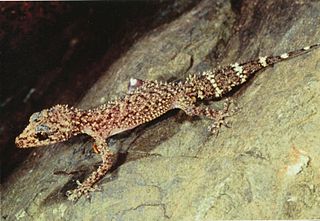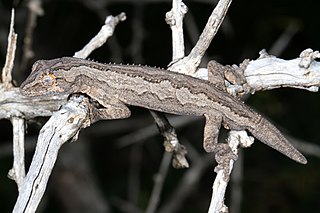
The beaded gecko is a gecko endemic to Australia.

Oedura is a genus of medium to large geckos, lizards in the family Diplodactylidae. The genus is endemic to Australia. Species in the genus are referred to by the common name velvet geckos.

The broad-headed snake is a species of venomous snake in the family Elapidae. The species is restricted to the Sydney Basin in New South Wales, Australia. It is one of three snakes in the genus Hoplocephalus, all restricted to eastern Australia. It is currently endangered in New South Wales and is listed as vulnerable under the Commonwealth Legislation.

Nephrurus amyae, also known commonly as the Centralian rough knob-tail gecko or the Centralian rough knob-tailed gecko, is a species of lizard in the family Carphodactylidae. It is the largest gecko in the genus Nephrurus, and like all species of Nephrurus is endemic to Australia.

Heteronotia binoei, also known commonly as the prickly gecko or Bynoe's gecko, is a species of lizard in the family Gekkonidae. The species is endemic to Australia. One of Australia's least habitat-specific geckos, it occurs naturally across much of the country, and has also established in areas where it does not occur naturally, such as urban Perth, Western Australia. It is dark brown to reddish brown, depending on the colour of the ground upon which it lives. There are irregular light bands with dark edges along its back.

The south-western spiny-tailed gecko, also known commonly as the soft spiny-tailed gecko, is a species of lizard in the family Diplodactylidae. The species is endemic to Australia. Two subspecies are recognized.

Champion's leaf-tailed gecko, also known commonly as the Koumala leaf-tailed gecko, is a species of gecko, a lizard in the family Carphodactylidae. The species is endemic to Australia.

Amalosia lesueurii, commonly known as Lesueur's gecko or Lesueur's velvet gecko, is a species of gecko, a lizard in the family Diplodactylidae. The species is endemic to Australia.

The northern spiny-tailed gecko is a species of lizard in the family Diplodactylidae. The species is endemic to Australia.
Lucasium byrnei, also known commonly as the gibber gecko, Byrne's gecko, and the pink-blotched gecko, is a species of small, nocturnal lizard in the family Diplodactylidae. The species is endemic to Australia.

Strophurus intermedius, also known commonly as the eastern spiny-tailed gecko or the southern spiny-tailed gecko, is a species of lizard in the family Diplodactylidae. The species is endemic to semi-arid regions of Australia in New South Wales, Northern Territory, South Australia, Victoria and Western Australia, in mallee shrubland and woodland habitats.

Amalosia is a genus of lizards in the family Diplodactylidae. The genus is endemic to Australia. It includes four species:

Amalosia jacovae, also known commonly as the clouded gecko or the clouded velvet gecko, is a species of lizard in the family Diplodactylidae. The species is endemic to Australia.
Amalosia obscura, also known commonly as the slim velvet gecko is a species of lizard in the family Diplodactylidae. The species is endemic to Australia.
The northern velvet gecko is a species of lizard in the family Diplodactylidae. The species is endemic to Queensland in Australia.

Oedura cincta, or inland marbled velvet gecko, is an Australian species of gecko.

Oedura coggeri, commonly known as the northern spotted velvet gecko, is a species of gecko, a lizard in the family Diplodactylidae. The species is endemic to Queensland, Australia.

The southern spotted velvet gecko, also known commonly as Tryon's velvet gecko, is a species of lizard in the family Diplodactylidae. The species is endemic to Australia.

Strophurus taenicauda, also known commonly as the golden spiny-tailed gecko or the golden-tailed gecko, is a species of lizard in the family Diplodactylidae. The species is endemic to eastern Australia. Three subspecies are recognized.
















